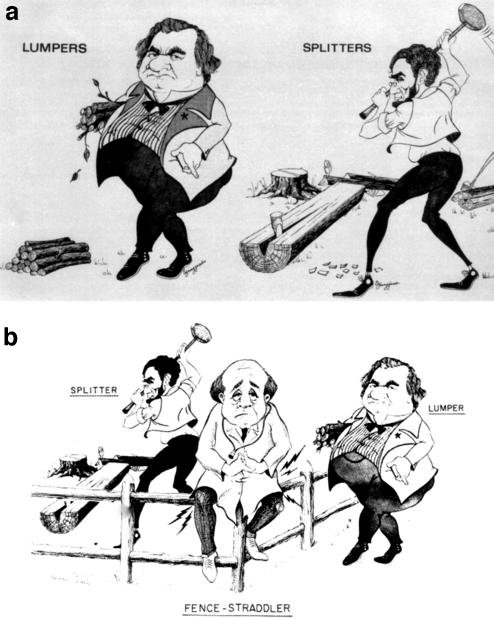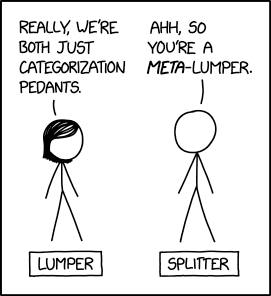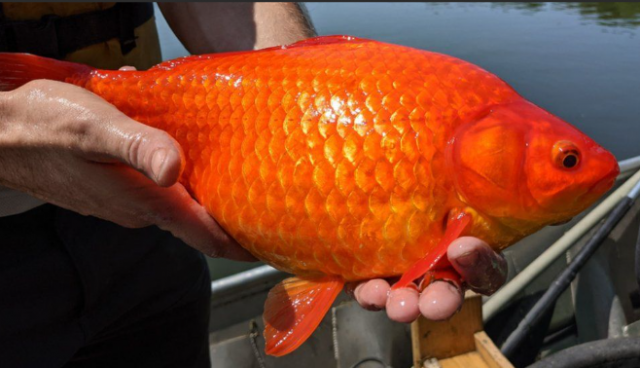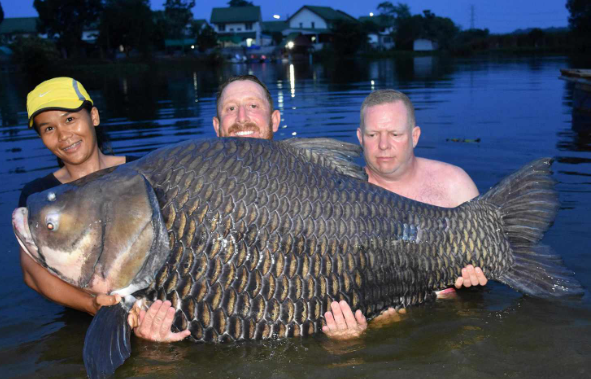Another winter has come and (mostly) gone, and the basement goldies are looking good. The biggest are about 7 inches or so, and the small number of last year's fry that were lucky enough to make it into the big tank are all in the 1.5 to 2 inch range. This tank has been at 50f to 55f for most of the winter, has now begun to rise and is about 60f currently. It gets at least one water change of at least 90% or more each week. It's filtered with a large sump and wet-dry filter, and has the initial pre-filter stage of the mechanical filtration replaced several times weekly, or even daily if I am feeling industrious. The fish are fed lightly every day, an assorted diet of various flakes, pellets, frozen food, etc. and their appetite and activity level has remained good all winter. They spend their free time (which is, of course,
all of their time...) picking up mouthfuls of the pool filter sand substrate, chewing it thoughtfully and then spitting it out. It builds up in drifts in the preferred spitting-out locations, and I periodically push it back more or less where I want it. For entertainment, they often try to steal a big algae wafer out of the mouth of the big Uruguayan pleco that lives with them; they never succeed, and he never acknowledges them.
In other words...these fish are maintained the way I feel that all fish should be kept: fed a good diet and kept in clean conditions with always-fresh water. Simple, really, and inevitably effective.
But...there are other goldfish down in the basement who don't have it quite so good. I overwinter a bunch of potted emergent plants, mostly papyrus, some wild garlic, and a few others, in a half-filled round stock tank. The tank is brightly illuminated and the plants seem to overwinter quite nicely in the cool basement air. Living in the water surrounding the pots is a handful of goldfish fry, siblings of the ones in the main tank. They have had no water changes all winter, just top-ups to replace evaporation. They get a tiny sprinkle of food a couple times per week; I doubt that any of it makes its way to the bottom during the ensuing feeding frenzy. The bottom is devoid of substrate, but is covered with a thick layer of detritus and mulm; aquarium keepers like to refer to this stuff in these terms because it sounds as though it's some valuable commodity that we nurture...but my granddaughters, with the honesty of youth, know what it is and call it by its correct name: fish poop.
This group of outlaws was introduced to the stock tank by the simple expedient of grabbing a big handful of guppy grass from the pond last fall and throwing it into the stock tank. It grows like wildfire, must be thinned on a regular basis, and the goldfish fry that came with it are now, surprisingly, just as big (all around 1.5 to 2 inches) as their lovingly nurtured siblings in the main tank, and look just as fat and healthy and happy. They're tough.
Pretty bad, huh? But wait...there's more...
In my den is a 30-ish gallon tank housing my Stinkpot turtle. He grew up with fish, and doesn't bother them, but the past few years he has been alone. He's pretty close to adult sized now, carapace length about 4 inches. He is fed a couple times weekly, in a separate bucket in which he stays until after his post-meal poop. His tank water is drained down to about 1/4-inch deep at least weekly, during feeding times, and replaced with clean fresh water. Bare ceramic tile bottom...almost no decor...and no plants, despite my efforts, because he eats 'em all. But last fall, I tossed in a handful of Guppy Grass harvested from my outdoor pond during its winterization cleanup. I assumed he'd mow it down immediately, but for some reason he doesn't like it and it is growing like crazy. It appears to have had a couple of goldfish fry in it when I threw it in; I noticed them a few days later, when they were very tiny, and didn't think much about them.
They're still in there; their diet consists of algae, turtle poop and (maybe) Guppy Grass. I've never actually seen them eat the GG, but can't discount the idea. I do know for a fact that I have never introduced any food of any kind into this tank since well before they ever appeared.
And... they are indistinguishable in size, activity and general health from the other ones in the other tanks. They are never fed, they flop around on their sides in a fraction of an inch of water during water changes, and in general have never had their asses kissed in any way, shape or form...and they look great!
Honestly...how can anybody not love goldfish? And now they are on the verge of ushering in a new paradigm in fish-nutrition thought and wisdom!

 for ages.
for ages. ...that Carassius auratus was a natural species and all of the varieties of it merely line-bred man-made creations.
...that Carassius auratus was a natural species and all of the varieties of it merely line-bred man-made creations.







